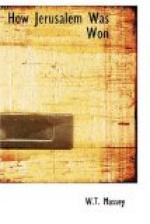and by 7.30 the station itself was occupied. Two
engines and 45 vehicles were found intact; two large
guns on trucks and over 100 prisoners were also taken.
The enemy shelled the station during the morning,
trying in vain to damage his lost rolling stock.
This booty was of immense value to us, and to a large
extent it solved the transport problem which at this
moment was a very anxious one indeed. The line
was metre gauge and we had no stock to fit it, though
later the Egyptian State Railways brought down some
engines and trucks from the Luxor-Assouan section,
but this welcome aid was not available till after
the rains had begun and had made lorry traffic temporarily
impossible between our standard gauge railhead and
our fighting front. Junction Station was no sooner
occupied than a light-railway staff under Colonel
O’Brien was brought up from Beit Hanun.
The whole of the line to Deir Sineid was not in running
order, but broken culverts were given minor repairs,
attention was bestowed on trucks, and the engines
were closely examined while the Turks were shelling
the station. The water tanks had been destroyed,
as a result of which two men spent hours in filling
up the engines by means of a water jug and basin found
in the station buildings, and the Turks had the mortification
of seeing these engines steam out of the station during
the morning to a cutting which was effective cover
from their field-gun fire. The light-railway
staff were highly delighted at their success, and the
trains which they soon had running over their little
system were indeed a boon and a blessing to the fighting
men and horses.
On this morning of November 14 the infantry were operating
with Desert Mounted Corps’ troops on both their
wings. The Australian Mounted Division was on
the right, fighting vigorous actions with the enemy
rearguards secreted in the irregular, rocky foothills
of the Shephelah which stand as ramparts to the Judean
Mountains. It was a difficult task to drive the
Turks out of these fastnesses, and while they held
on to them it was almost impossible to outflank some
of the places like Et Tineh, a railway station and
camp of some importance on the line to Beersheba.
They had already had some stiff fighting at Tel el
Safi, the limestone hill which was the White Guard
of the Crusaders. The Division suffered severely
from want of water, particularly the 5th Mounted Brigade,
and it was necessary to transfer to it the 7th Mounted
Brigade and the 2nd Australian Light Horse Brigade.
On the left of the infantry the Yeomanry Mounted Division
was moving forward from Akir and Mansura, and after
the 22nd Mounted Brigade had taken Naaneh they detailed
a demolition party to blow up one mile of railway,
so that, even if the 75th Division had not taken Junction
Station, Jerusalem would have been entirely cut off
from railway communication with the Turkish base at
Tul Keram, and Haifa and Damascus.




